| Listing 1 - 10 of 10 |
Sort by
|
Dissertation
ISBN: 9056820362 Year: 1996 Publisher: Heverlee Katholieke Universiteit Leuven. Faculteit der Toegepaste Wetenschappen. Departement Elektrotechniek. Afdeling Elektronica, Systemen, Automatisatie en Technologie
Abstract | Keywords | Export | Availability | Bookmark
 Loading...
Loading...Choose an application
- Reference Manager
- EndNote
- RefWorks (Direct export to RefWorks)
Proefschriften --- Thèses --- Academic collection --- 681.3*I42 --- #BIBC:T1996 --- Compression (coding): approximate methods; exact coding (Image processing)--See also {681.3*E4} --- Theses --- 681.3*I42 Compression (coding): approximate methods; exact coding (Image processing)--See also {681.3*E4}
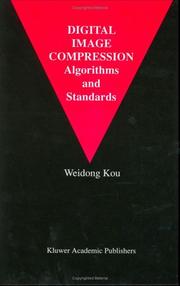
ISBN: 079239626X 1441951563 147572361X 9780792396260 Year: 1995 Volume: 333 Publisher: Boston Kluwer
Abstract | Keywords | Export | Availability | Bookmark
 Loading...
Loading...Choose an application
- Reference Manager
- EndNote
- RefWorks (Direct export to RefWorks)
Information systems --- imaging --- data compressie --- Artificial intelligence. Robotics. Simulation. Graphics --- algoritmen --- Computer science --- Computer algorithms --- Image compression --- Image processing --- Algorithmes --- Compression d'images --- Traitement d'images --- Digital techniques --- Techniques numériques --- 681.3*I42 --- #TELE:MI2 --- Compression (coding): approximate methods; exact coding (Image processing)--See also {681.3*E4} --- 681.3*I42 Compression (coding): approximate methods; exact coding (Image processing)--See also {681.3*E4} --- Techniques numériques --- Digital image processing --- Digital electronics --- Image data compression --- Data compression (Telecommunication) --- Algorithms --- Image processing - Digital techniques
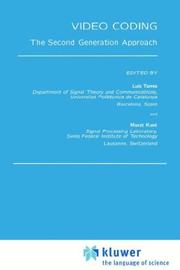
ISBN: 0792396804 9780792396802 1461285755 1461313376 Year: 1996 Publisher: Boston Kluwer
Abstract | Keywords | Export | Availability | Bookmark
 Loading...
Loading...Choose an application
- Reference Manager
- EndNote
- RefWorks (Direct export to RefWorks)
Digital video --- Video compression --- 681.3*I42 --- Compression (coding): approximate methods; exact coding (Image processing)--See also {681.3*E4} --- 681.3*I42 Compression (coding): approximate methods; exact coding (Image processing)--See also {681.3*E4} --- Coding theory --- Video data compression --- Image compression --- Digital motion video --- PC video --- Video, Digital --- Computer graphics --- Digital media --- Image processing --- Multimedia systems --- Data compression (Telecommunication) --- Digital electronics --- Information theory --- Machine theory --- Signal theory (Telecommunication) --- Computer programming --- Digital techniques
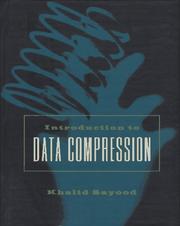
ISBN: 1558603468 Year: 1996 Publisher: San Francisco (Calif.): Morgan Kaufmann
Abstract | Keywords | Export | Availability | Bookmark
 Loading...
Loading...Choose an application
- Reference Manager
- EndNote
- RefWorks (Direct export to RefWorks)
Mathematical control systems --- Coding theory --- Data compression (Telecommunication) --- Codage --- Données --- Compression (Télécommunications) --- 621.391.3 --- 681.3*I42 --- Transmission of electric signals by conduction --- Compression (coding): approximate methods; exact coding (Image processing)--See also {681.3*E4} --- Coding theory. --- Data compression (Telecommunication). --- 681.3*I42 Compression (coding): approximate methods; exact coding (Image processing)--See also {681.3*E4} --- 621.391.3 Transmission of electric signals by conduction --- Données --- Compression (Télécommunications) --- Compression of data (Telecommunication) --- Data compression (Computer science) --- Data transmission systems --- Digital electronics --- Information theory --- Machine theory --- Signal theory (Telecommunication) --- Computer programming
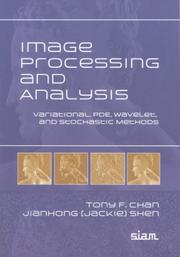
ISBN: 089871589X 9780898715897 Year: 2005 Publisher: Philadelphia Society for industrial and applied mathematics
Abstract | Keywords | Export | Availability | Bookmark
 Loading...
Loading...Choose an application
- Reference Manager
- EndNote
- RefWorks (Direct export to RefWorks)
Stochastic processes --- Artificial intelligence. Robotics. Simulation. Graphics --- Operational research. Game theory --- Image processing --- Traitement d'images --- Mathematical models --- Modèles mathématiques --- 681.3*I42 --- 519.63 --- 519.22 --- Compression (coding): approximate methods; exact coding (Image processing)--See also {681.3*E4} --- Numerical methods for solution of partial differential equations --- Statistical theory. Statistical models. Mathematical statistics in general --- 519.22 Statistical theory. Statistical models. Mathematical statistics in general --- 519.63 Numerical methods for solution of partial differential equations --- 681.3*I42 Compression (coding): approximate methods; exact coding (Image processing)--See also {681.3*E4} --- Modèles mathématiques --- Pictorial data processing --- Picture processing --- Processing, Image --- Imaging systems --- Optical data processing
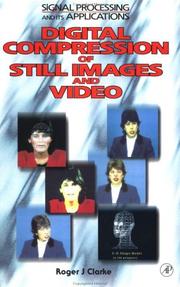
ISBN: 012175720X Year: 1995 Publisher: London Academic press
Abstract | Keywords | Export | Availability | Bookmark
 Loading...
Loading...Choose an application
- Reference Manager
- EndNote
- RefWorks (Direct export to RefWorks)
Coding theory --- Digital video --- Image compression --- Image processing --- Image transmission --- Television bandwidth compression --- Codage --- Vidéo numérique --- Compression d'images --- Traitement d'images --- Transmission des images --- Digital techniques --- Techniques numériques --- 681.3*I42 --- Video compression --- Video data compression --- Image data compression --- Data compression (Telecommunication) --- Digital motion video --- PC video --- Video, Digital --- Computer graphics --- Digital media --- Multimedia systems --- Digital electronics --- Information theory --- Machine theory --- Signal theory (Telecommunication) --- Computer programming --- Compression (coding): approximate methods; exact coding (Image processing)--See also {681.3*E4} --- Coding theory. --- Digital video. --- Image compression. --- Video compression. --- 681.3*I42 Compression (coding): approximate methods; exact coding (Image processing)--See also {681.3*E4} --- Vidéo numérique --- Techniques numériques

ISBN: 0387942114 9780387942117 3540942114 Year: 1995 Publisher: New York : Springer Verlag,
Abstract | Keywords | Export | Availability | Bookmark
 Loading...
Loading...Choose an application
- Reference Manager
- EndNote
- RefWorks (Direct export to RefWorks)
Fractals. --- Image compression. --- Image processing --- Digital techniques. --- Image compression --- -Pictorial data processing --- Image data compression --- Compression (coding): approximate methods; exact coding (Image processing)--See also {681.3*E4} --- -Compression (coding): approximate methods; exact coding (Image processing)--See also {681.3*E4} --- 681.3*I42 Compression (coding): approximate methods; exact coding (Image processing)--See also {681.3*E4} --- -Image data compression --- Fractals --- 681.3*I42 --- Data compression (Telecommunication) --- Fractal geometry --- Fractal sets --- Geometry, Fractal --- Sets, Fractal --- Sets of fractional dimension --- Dimension theory (Topology) --- Digital image processing --- Digital electronics --- Digital techniques --- Stochastic processes --- Artificial intelligence. Robotics. Simulation. Graphics --- Image processing - Digital techniques
Book
ISBN: 1107127068 1107385172 1280414871 9786610414871 0511800460 0511202822 0511178697 0511077408 0511305907 0511075839 9780511077401 9780511800467 9781107385177 9780511202827 0521553741 9780521553742 0521556597 9780521556590 Year: 2003 Publisher: New York Cambridge University Press
Abstract | Keywords | Export | Availability | Bookmark
 Loading...
Loading...Choose an application
- Reference Manager
- EndNote
- RefWorks (Direct export to RefWorks)
The need to transmit and store massive amounts of data reliably and without error is a vital part of modern communications systems. Error-correcting codes play a fundamental role in minimising data corruption caused by defects such as noise, interference, crosstalk and packet loss. This book provides an accessible introduction to the basic elements of algebraic codes, and discusses their use in a variety of applications. The author describes a range of important coding techniques, including Reed-Solomon codes, BCH codes, trellis codes, and turbocodes. Throughout the book, mathematical theory is illustrated by reference to many practical examples. The book was first published in 2003 and is aimed at graduate students of electrical and computer engineering, and at practising engineers whose work involves communications or signal processing.
Data transmission systems --- Signal processing --- Data communication systems --- Transmission of data --- Digital communications --- Electronic data processing --- Electronic systems --- Information theory --- Telecommunication systems --- Mathematical models. --- Mathematics. --- Data transmission systems - Mathematical models --- Signal processing - Mathematics --- 681.3*E4 --- 681.3*I42 --- 681.3*I42 Compression (coding): approximate methods; exact coding (Image processing)--See also {681.3*E4} --- Compression (coding): approximate methods; exact coding (Image processing)--See also {681.3*E4} --- 681.3*E4 Coding and information theory: data compaction and compression; formal modelsof communication; nonsecret encoding schemes--See also {681.3*H11} --- Coding and information theory: data compaction and compression; formal modelsof communication; nonsecret encoding schemes--See also {681.3*H11} --- Mathematical models --- Mathematics
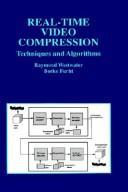
ISBN: 0792397878 9780585323135 0585323135 Year: 1997 Volume: SECS 376 Publisher: Boston ; Dordrecht ; London : Kluwer Academic Publishers,
Abstract | Keywords | Export | Availability | Bookmark
 Loading...
Loading...Choose an application
- Reference Manager
- EndNote
- RefWorks (Direct export to RefWorks)
Real-Time Video Compression: Techniques and Algorithms introduces the XYZ video compression technique, which operates in three dimensions, eliminating the overhead of motion estimation. First, video compression standards, MPEG and H.261/H.263, are described. They both use asymmetric compression algorithms, based on motion estimation. Their encoders are much more complex than decoders. The XYZ technique uses a symmetric algorithm, based on the Three-Dimensional Discrete Cosine Transform (3D-DCT). 3D-DCT was originally suggested for compression about twenty years ago; however, at that time the computational complexity of the algorithm was too high, it required large buffer memory, and was not as effective as motion estimation. We have resurrected the 3D-DCT-based video compression algorithm by developing several enhancements to the original algorithm. These enhancements make the algorithm feasible for real-time video compression in applications such as video-on-demand, interactive multimedia, and videoconferencing. The demonstrated results, presented in this book, suggest that the XYZ video compression technique is not only a fast algorithm, but also provides superior compression ratios and high quality of the video compared to existing standard techniques, such as MPEG and H.261/H.263. The elegance of the XYZ technique is in its simplicity, which leads to inexpensive VLSI implementation of any XYZ codec. Real-Time Video Compression: Techniques and Algorithms can be used as a text for graduate students and researchers working in the area of real-time video compression. In addition, the book serves as an essential reference for professionals in the field.
Multimedia systems --- Real-time data processing --- Video compression --- Multimédia --- Temps réel --- Compression vidéo --- 681.3*I42 --- Video data compression --- Image compression --- Fast-response data processing --- High-speed data processing --- Electronic data processing --- Computer-based multimedia information systems --- Multimedia computing --- Multimedia information systems --- Multimedia knowledge systems --- Information storage and retrieval systems --- Compression (coding): approximate methods; exact coding (Image processing)--See also {681.3*E4} --- Multimedia systems. --- Real-time data processing. --- Video compression. --- Computer Science --- Engineering & Applied Sciences --- 681.3*I42 Compression (coding): approximate methods; exact coding (Image processing)--See also {681.3*E4} --- Multimédia --- Temps réel --- Compression vidéo --- Engineering. --- Computer science. --- Computer communication systems. --- Special purpose computers. --- Electrical engineering. --- Electrical Engineering. --- Special Purpose and Application-Based Systems. --- Computer Communication Networks. --- Computer Science, general. --- Computer engineering. --- Software engineering. --- Informatics --- Science --- Communication systems, Computer --- Computer communication systems --- Data networks, Computer --- ECNs (Electronic communication networks) --- Electronic communication networks --- Networks, Computer --- Teleprocessing networks --- Data transmission systems --- Digital communications --- Electronic systems --- Information networks --- Telecommunication --- Cyberinfrastructure --- Network computers --- Special purpose computers --- Computers --- Electric engineering --- Engineering --- Distributed processing
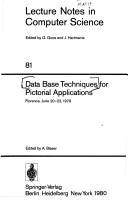
ISBN: 0387097635 1441935304 9786611875749 1281875740 0387097643 3540097635 3540386513 3540097643 3540389466 9783540097648 Year: 1980 Volume: 786 Publisher: Berlin ; New York : Springer-Verlag,
Abstract | Keywords | Export | Availability | Bookmark
 Loading...
Loading...Choose an application
- Reference Manager
- EndNote
- RefWorks (Direct export to RefWorks)
The ease of access, relative anonymity, and borderless nature of the Internet has allowed widespread computer-based crime – or cybercrime – to proliferate rapidly. Law enforcement and international security organizations, along with governments and the private sector, have only recently begun to appreciate the scope, severity and transnational nature of this problem. In recent years, organizations have begun to emerge and evolve in a progressively collaborative ecosystem of vested international bodies seeking to address these challenges in unique, innovative ways. This study attempts to address a series of questions regarding the current state of cyber security. What does the international landscape of cyber security look like today? What are these organizations actually doing? Are they succeeding? What measureable progress has been made in developing a supportive ecosystem of global cyber security? Are these organizations presenting practical, innovative, collaborative, and sustainable solutions to address these issues? Global Initiatives to Secure Cyberspace: An Emerging Landscape is designed for a professional audience composed of researchers, practitioners and the government, focusing on a secure cyberspace industry. Advanced-level students in computer science will also find this book suitable. .
Cartography --Data processing --Congresses. --- Computer graphics --Congresses. --- Image processing --Congresses. --- Optical data processing --Congresses. --- Computer security --- Computer networks --- Cyberterrorism --- Telecommunications --- Computer Science --- Engineering & Applied Sciences --- Electrical & Computer Engineering --- Security measures --- Prevention --- Computer security. --- Security measures. --- Prevention. --- Attacks on computers --- Computer attacks --- Cyber attacks --- Cyber terrorism --- Cyber war --- Cyberwarfare --- Communication systems, Computer --- Computer communication systems --- Data networks, Computer --- ECNs (Electronic communication networks) --- Electronic communication networks --- Networks, Computer --- Teleprocessing networks --- Computer privacy --- Computer system security --- Computer systems --- Computers --- Cyber security --- Cybersecurity --- Electronic digital computers --- Security of computer systems --- Computer network security --- Network security, Computer --- Security of computer networks --- Protection of computer systems --- Protection --- 681.3*I42 --- #TCPW P4.5 --- 681.3*I33 --- Compression (coding): approximate methods exact coding (Image processing)--See also {681.3*E4} --- Database management: security integrity protection--See also {?681.5*E5} --- Picture/image generation: digitizing and scanning display algorithms viewing algorithms (Computer graphics) --- Graphics utilities: picture desciption languages software support (Computer graphics) --- 681.3*I34 Graphics utilities: picture desciption languages software support (Computer graphics) --- 681.3*I33 Picture/image generation: digitizing and scanning display algorithms viewing algorithms (Computer graphics) --- 681.3*H2m Database management: security integrity protection--See also {?681.5*E5} --- 681.3*I42 Compression (coding): approximate methods exact coding (Image processing)--See also {681.3*E4} --- Infinite matrices. --- Summability theory. --- Computer science. --- Computer organization. --- Computer communication systems. --- Data structures (Computer science). --- Data encryption (Computer science). --- Computer Science. --- Systems and Data Security. --- Computer Communication Networks. --- Data Encryption. --- Information Systems Applications (incl. Internet). --- Data Structures, Cryptology and Information Theory. --- Computer Systems Organization and Communication Networks. --- Information systems --- Data protection --- Security systems --- Hacking --- Data encoding (Computer science) --- Encryption of data (Computer science) --- Cryptography --- Information structures (Computer science) --- Structures, Data (Computer science) --- Structures, Information (Computer science) --- Electronic data processing --- File organization (Computer science) --- Abstract data types (Computer science) --- Data transmission systems --- Digital communications --- Electronic systems --- Information networks --- Telecommunication --- Cyberinfrastructure --- Network computers --- Organization, Computer --- Informatics --- Science --- Distributed processing --- #TCPW P4.0 --- #TCPW P4.2 --- 681.3*A0 --- 681.3*H2m --- 681.3*I34 --- 681.3*I34 Graphics utilities: picture desciption languages; software support (Computer graphics) --- Graphics utilities: picture desciption languages; software support (Computer graphics) --- 681.3*I33 Picture/image generation: digitizing and scanning; display algorithms; viewing algorithms (Computer graphics) --- Picture/image generation: digitizing and scanning; display algorithms; viewing algorithms (Computer graphics) --- 681.3*A0 General --- General --- 681.3*I42 Compression (coding): approximate methods; exact coding (Image processing)--See also {681.3*E4} --- Compression (coding): approximate methods; exact coding (Image processing)--See also {681.3*E4} --- 681.3*H2m Database management: security; integrity; protection--See also {?681.5*E5} --- Database management: security; integrity; protection--See also {?681.5*E5} --- Operator theory --- Computer crimes --- Terrorism --- Operator theory. --- Computer graphics --- Cartography --- Infographie --- Cartographie --- Data processing --- Informatique --- Data structures (Computer scienc. --- Computer network architectures. --- Cryptology. --- Data Structures and Information Theory. --- Architectures, Computer network --- Network architectures, Computer --- Computer architecture --- Computer vision. --- Models and Principles. --- Image Processing and Computer Vision. --- Machine vision --- Vision, Computer --- Artificial intelligence --- Image processing --- Pattern recognition systems --- Matrices. --- Application software. --- Application computer programs --- Application computer software --- Applications software --- Apps (Computer software) --- Computer software --- Matrices --- Théorèmes taubériens --- Suites et series --- Sommabilite
| Listing 1 - 10 of 10 |
Sort by
|

 Search
Search Feedback
Feedback About UniCat
About UniCat  Help
Help News
News